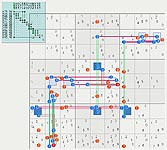Here a selection in my list of hard puzzle of some puzzle giving something different
- Code: Select all
100000005020400060003000700040006000000049080002800000000050100060900020007000003 col803# 98781
- Code: Select all
1 789 46 |2367 236789 2378 |23489 349 5
5789 2 589 |4 13789 13578 |389 6 189
46 589 3 |1256 12689 1258 |7 149 12489
--------------------------------------------------------
35789 4 1589 |12357 1237 6 |2359 13579 1279
3567 1357 156 |12357 4 9 |2356 8 1267
35679 13579 2 |8 137 1357 |34569 134579 14679
--------------------------------------------------------
23489 389 489 |2367 5 23478 |1 479 46789
3458 6 1458 |9 1378 13478 |458 2 478
24589 1589 7 |126 1268 1248 |45689 459 3
floors1357 permutations =85
- Code: Select all
N:.....................................X...........XX..............................
R:.XXXXX.XX.........XX.XXXXX...........XXXXX.XX.........XX.XXXXX...................
C:.XXXXX.XX.........XX.XXXXX..........XXXX.XXX..........XX.XXX.XX..................
B:.XXXXXXX...........XXXXXXX..........XX.XXXX.X.........XX.XXX.XX..................
1 2 3 4 5 6 7 8 9
HC.x.xxxxx.x.x.xxx.x.x.xxx.xxx.xxx.xxxx.xx..x.xxx....xxxxx.x.x.xxx.x.xxx.xxx.xxxxx.
NE..................................x....x.........................................
1: r3c9
3: r4c5
Nothing really special, just a mix not to rich candidates and nodes
- Code: Select all
100000005020400060003000700040809000000046080000000200007001000080900020500000300 col807# 95104
- Code: Select all
1 679 4689 |2367 236789 2378 |489 349 5
789 2 589 |4 135789 3578 |189 6 1389
4689 569 3 |156 15689 58 |7 149 2
----------------------------------------------------------
2367 4 1256 |8 12357 9 |156 1357 1367
2379 13579 1259 |12357 4 6 |159 8 1379
36789 135679 15689 |1357 1357 357 |2 134579 134679
----------------------------------------------------------
23469 369 7 |2356 23568 1 |45689 459 4689
346 8 146 |9 3567 3457 |1456 2 1467
5 169 12469 |267 2678 2478 |3 1479 146789
- Code: Select all
4: r8c9r9c89
floors4 permutations =8
actifs
R:...........................X.X..XXXX.............................................
C:...........................X.X..XXXX.............................................
B:...........................X.X..XXXX.............................................
1 2 3 4 5 6 7 8 9
An example where the start of my solver is three turbots
- Code: Select all
000100030000000065003060800008090006070002000000400000009080050020001000400700900 col080502
- Code: Select all
256789 45689 24567 |1 2457 45789 |247 3 2479
12789 1489 1247 |238 2347 34789 |1247 6 5
12579 1459 3 |25 6 4579 |8 12479 12479
-------------------------------------------------------
1235 1345 8 |35 9 357 |123457 1247 6
13569 7 1456 |68 135 2 |1345 1489 13489
123569 13569 1256 |4 1357 68 |12357 12789 123789
-------------------------------------------------------
1367 136 9 |236 8 346 |123467 5 12347
35678 2 567 |9 345 1 |3467 478 3478
4 13568 156 |7 235 356 |9 128 1238
floors156 permutations =4745
N:..........................................................................X......
R:.XXXXXX.X...........................X.XXXX.XXX...XXXXX...........................
C:XXX.X.XXX...........................XXXXXXX..XXXX.XX.............................
B:X.XXXXX.X...........................XX.XXXXX.X..XX.XXX...........................
1 2 3 4 5 6 7 8 9
total =61 sets actifs
HCxxx.xx...xxx...x..xx.x.x.xxxx.x.xxx.x.xxx.xxxxxx.xxxxxxx.x.xx.xx.x.x.x...x..xx.xx
assigned 6: r5c4
eliminations
6: r5c13r6c6r7c4
NE.......................................x.........................................
here a mix with the three cases : asigment, eliminations of candidates and node to clear
and the same results using floors 236
- Code: Select all
N:.........................................................X.......................
R:.........XXXX.XX.X.X.XXXXXX..................X...XXXXX...........................
C:.........X.XXX.XXXXX.XXXX.X..................XXXX.XX.............................
B:.........XXXX.X.XX.X.XXXXXX..................X..XX.XXX...........................
1 2 3 4 5 6 7 8 9
total =61 sets actifs
HCxxx.x.x.xx.xxxxx..x..x...xxxx.x.xxx.x.xxx.x.xxxx.xxxxxxx...xx.xx.x.x.x.x.xx.xx.xx
and with floors 567
- Code: Select all
N:.................................................................X...............
R:....................................X.XXXX.XXX...XXXXXXXXX.XXX...................
C:....................................XXXXXXX..XXXX.XX..X.X.XXXXX..................
B:....................................XX.XXXXX.X..XX.XXXXXX.XXX.X..................
1 2 3 4 5 6 7 8 9
total =61 sets actifs
HCxxx.xxx.xx.x.xxx..xx.x.x.xxxx.x.xxx.x.xxx.x..xxx.xxxxxxx.x.xx.xx...x.xxx.xx.xx...
using floors 357, only the clearing of another node appears
éliminations trouvées
- Code: Select all
NE...................................................................x.............
floors357 permutations =6525
N:..............................X.X................................................
R:...................X.XXXXXX.........X.XXXX.XX.........XXXX.XXX...................
C:..................XX.XXXX.X.........XXXXXXX...........X.X.XXXXX..................
B:...................X.XXXXXX.........XX.XXXXX..........XXX.XXX.X..................
1 2 3 4 5 6 7 8 9
total =65 sets actifs
HCxxx.xxx.xx.xxxxx..xx.x.x.xxxx....xx.x.x.x.x.xxxx.x.xxxxx.x.xx.xx.x.x.xxx.xx.xx..x
- Code: Select all
000010005020400090003000700040006000000049080000800002007000100060900020500000003 col810# 95384
- Code: Select all
46789 789 4689 |367 1 378 |2 346 5
1678 2 1568 |4 35678 3578 |368 9 168
1468 158 3 |256 9 258 |7 146 1468
---------------------------------------------------------
123789 4 12589 |12357 2357 6 |359 1357 179
12367 1357 1256 |12357 4 9 |356 8 167
13679 13579 1569 |8 357 1357 |34569 134567 2
---------------------------------------------------------
23489 389 7 |2356 23568 23458 |1 456 4689
1348 6 148 |9 3578 134578 |458 2 478
5 189 12489 |1267 2678 12478 |4689 467 3
I'll come back with an edit for that one.
The solver did not find any possibility combining up to four floors.
I added a possibility to combine five floors and I will check it to day.
- Code: Select all
000001009000000085009050060008030006070002000100400000003080050400700000020000300 col401# 98353
- Code: Select all
235678 34568 24567 |2368 2467 1 |247 2347 9
2367 1346 12467 |2369 24679 4679 |1247 8 5
2378 1348 9 |238 5 478 |1247 6 12347
---------------------------------------------------------
259 459 8 |159 3 579 |124579 12479 6
3569 7 456 |15689 169 2 |14589 1349 1348
1 3569 256 |4 679 56789 |25789 2379 2378
---------------------------------------------------------
679 169 3 |1269 8 469 |124679 5 1247
4 15689 156 |7 1269 3 |12689 129 128
6789 2 167 |1569 1469 4569 |3 1479 1478
A second example with two possibilities to combine 4 floors
The best one
floors1247 permutations =9
- Code: Select all
N:......X........X........X.....................................X..................
R:.XXXX.XXXXXXX.XXX..........XXXXX.X.X..................XXXX.XX.X..................
C:.XXXX.XXXX.XXX.XXX..........XX.XXXXX..................X.X.XXXXX..................
B:X.X.XXXXXXXXX.X.XX.........XXXX.X.XX..................XXX.XXX.X..................
1 2 3 4 5 6 7 8 9
HCxxxxx..x.xxxxxx...xx.x.x..xxx.x.xxx...xxx.xxx..x.xxxxxxx.x.xx...xx.x.xxxx.xxxx.xx
1: r4c8r5c47r7c7r8c279r9c49
2: r1c148r2c4r678c7
4: r1c28r2c36r57c7r9c6
7: r1c18r2c67r3c1r4c7r6c67r7c9r9c1
NE..x.x......x.x............x.......x......................x.....................x.
and a very limted effect (one node to clear) using
floors1678 permutations =16150
actifs
- Code: Select all
N:..........................................................................X......
R:.XXXX.XXX....................................XX..XXXXXXXXX.XX.XX.X.XX.XX.........
C:.XXXX.XXX....................................XXXXXXX..X.X.XXXXXXX.X.XX.X.........
B:X.X.XXXXX....................................XX.XX.XXXXXX.XXX.XXX..XXX.X.........
1 2 3 4 5 6 7 8 9
HCxxxxx.xx.xxxxxxx..xx.x.xx.x...x.xxx.x.xxx.xxx.xx.xxxxxxx.x.xx.x.xx.x.xxxx..xxx.xx
NE........................................................................x........


